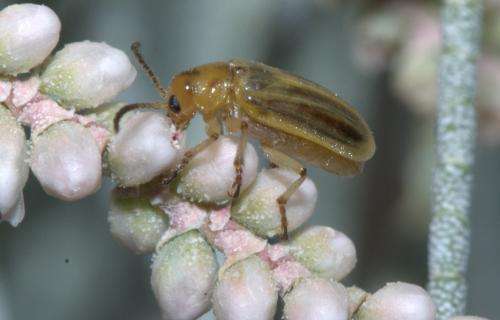Imported 'bio-beetles' attack invasive saltcedar

(Â鶹ÒùÔº)—Sometimes it takes a foreign ally to conquer a foreign invader. Such is the case with saltcedar, said a Texas AgriLife Extension Service entomologist.
Since 2006, a steadily growing army of tiny beetles from the invasive trees' homelands of Crete and Tunisia have been providing biological control of the pest by eating their way through saltcedar thickets to slowly weaken the foe, said Dr. Allen Knutson, AgriLife Extension entomologist at Dallas.
"Most Texans who spend time along West Texas' rivers, streams and reservoirs recognize saltcedar," Knutson said. "It was introduced into the U.S. as an ornamental plant in the early 1800s, but unfortunately it escaped to become an invasive species. Today, dense thickets of saltcedar choke out desirable vegetation, use large amounts of groundwater and increase the risk of flooding as trees narrow the river channel."
Saltcedar infests some 500,000 acres in Texas, Knutson said. He added that herbicides are effective but very costly.
Saltcedar arrived in the U.S. without its natural enemies, he said. Biological control reunites the saltcedar with its natural enemies, limiting the trees' invasive nature.
"We have been working to establish the leaf beetles for biological control of saltcedar since 2006," he said. "To date, we have collected and released over 800,000 beetles in 15 West Texas counties. This year, we are starting to see the area-wide impact of this effort as beetles have defoliated saltcedar thickets along miles of the Rio Grande, Pecos, Colorado and Upper Brazos Rivers. Once established, these 'bio-beetles' should persist without the need for additional releases."
He said the small beetles and their larvae eat saltcedar leaves. Without leaves, the trees slowly starve to death. "Not many of these trees are 'graveyard dead' yet, but over time, our research and experience has shown canopies will die back and in some sites, trees will die as the beetles return each year and defoliate the trees."
In the meantime, Knutson and Dr. Mark Muegge, AgriLife Extension entomologist at Fort Stockton, said the defoliated saltcedar trees aren't using as much water or shading out desirable species. And the defoliated trees produce few or no seeds. The saltcedar beetles eat only saltcedar and athel, a closely related tree that grows in South Texas.
Knutson said the beetle project originated with work done by Jack DeLoach, U.S. Department of Agriculture-Agricultural Research Service entomologist at Temple. Texas AgriLife soon joined the effort and has since led the beetle implementation program through educational programs, applied research and redistribution of the insects to establish them at new sites.
"The saltcedar biological control program has the potential to provide a low-cost, environmentally safe and sustainable approach to managing a widespread, invasive species that impacts ranching, agriculture, recreation and water issues across the state," Knutson said.
More information: For more information about saltcedar control see: .
Provided by Texas A&M AgriLife

















